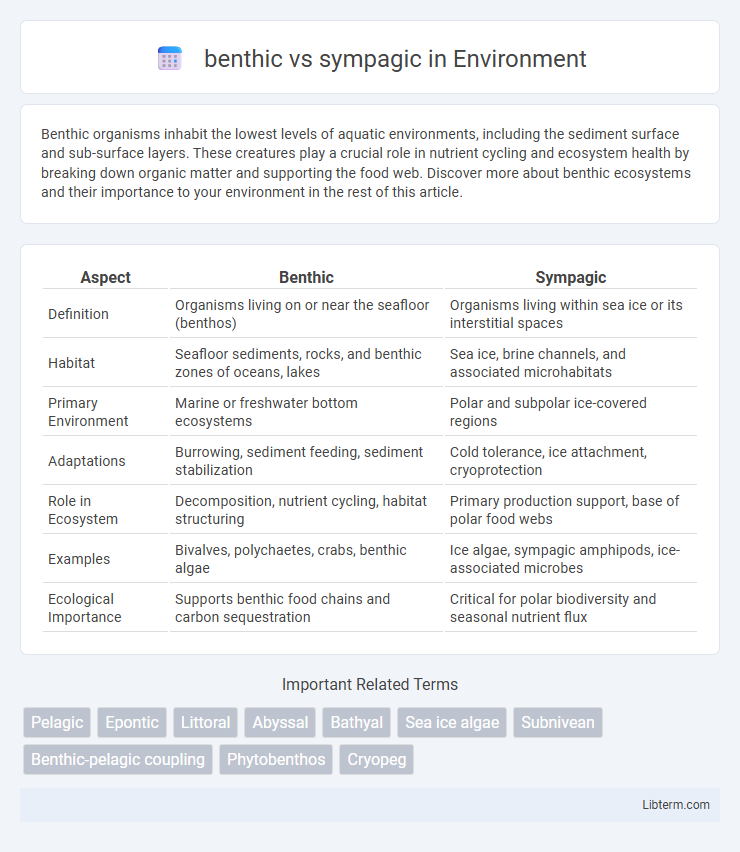Benthic organisms inhabit the lowest levels of aquatic environments, including the sediment surface and sub-surface layers. These creatures play a crucial role in nutrient cycling and ecosystem health by breaking down organic matter and supporting the food web. Discover more about benthic ecosystems and their importance to your environment in the rest of this article.
Table of Comparison
| Aspect | Benthic | Sympagic |
|---|---|---|
| Definition | Organisms living on or near the seafloor (benthos) | Organisms living within sea ice or its interstitial spaces |
| Habitat | Seafloor sediments, rocks, and benthic zones of oceans, lakes | Sea ice, brine channels, and associated microhabitats |
| Primary Environment | Marine or freshwater bottom ecosystems | Polar and subpolar ice-covered regions |
| Adaptations | Burrowing, sediment feeding, sediment stabilization | Cold tolerance, ice attachment, cryoprotection |
| Role in Ecosystem | Decomposition, nutrient cycling, habitat structuring | Primary production support, base of polar food webs |
| Examples | Bivalves, polychaetes, crabs, benthic algae | Ice algae, sympagic amphipods, ice-associated microbes |
| Ecological Importance | Supports benthic food chains and carbon sequestration | Critical for polar biodiversity and seasonal nutrient flux |
Introduction to Benthic and Sympagic Ecosystems
Benthic ecosystems, located at the bottom of aquatic environments, support diverse communities of organisms adapted to sedimentary habitats, including worms, mollusks, and crustaceans. Sympagic ecosystems exist within and beneath sea ice, hosting microorganisms such as algae and ice-associated fauna that thrive in extreme, cold conditions. Both habitats play crucial roles in nutrient cycling and serve as vital food sources within polar and temperate marine food webs.
Defining Benthic Environments
Benthic environments refer to the ecological regions at the lowest level of a body of water, including the sediment surface and sub-surface layers, where organisms such as polychaetes, crustaceans, and benthic algae thrive. These habitats are characterized by low light penetration and varying oxygen levels depending on depth and organic matter decomposition. Benthic zones contrast with sympagic environments, which are defined by life associated with sea ice, supporting microbial communities and ice-associated fauna.
What Are Sympagic Communities?
Sympagic communities are ecosystems that inhabit the sea ice environment, consisting of microorganisms, algae, and small invertebrates adapted to live within or on the underside of the ice. These communities play a crucial role in polar food webs by providing essential nutrients and energy to larger marine animals. Unlike benthic communities that dwell on the ocean floor, sympagic organisms thrive in the unique conditions created by sea ice, influencing biogeochemical cycles in polar regions.
Key Differences Between Benthic and Sympagic Zones
The benthic zone refers to the ecological region at the lowest level of a body of water, including the sediment surface and some sub-surface layers, supporting organisms such as sea stars, crabs, and benthic algae. In contrast, the sympagic zone is associated specifically with sea ice environments and encompasses organisms living within, on, or under the ice, including ice algae, sympagic amphipods, and bacteria. Key differences include habitat location, with benthic zones found at the seabed across aquatic systems, while sympagic zones exist within polar ice habitats, influencing distinct adaptations and ecological interactions.
Species Adaptations in Benthic vs Sympagic Habitats
Benthic species exhibit adaptations such as strong attachment mechanisms, camouflage, and sediment-burrowing abilities to thrive on or within the ocean floor, where light availability is limited and pressures are higher. Sympagic species, inhabiting sea ice ecosystems, have specialized antifreeze proteins, flattened bodies for navigating ice channels, and physiological tolerance to freezing temperatures. These contrasting adaptations reflect the distinct environmental pressures in benthic versus sympagic habitats, driving species divergence in morphology, metabolism, and reproductive strategies.
Ecological Roles of Benthic and Sympagic Organisms
Benthic organisms, found on or near the seabed, play crucial roles in nutrient recycling, sediment stabilization, and serving as a primary food source for higher trophic levels in marine ecosystems. Sympagic organisms inhabit sea ice environments, contributing significantly to primary production during polar seasons and supporting complex food webs by providing essential energy transfers between ice-associated and open-water species. Together, benthic and sympagic communities maintain ecological balance and resilience, particularly in Arctic and Antarctic marine habitats where they drive biogeochemical cycles and influence biodiversity patterns.
Primary Productivity Comparison: Benthic vs Sympagic
Benthic primary productivity, driven by photosynthetic organisms on or near the seafloor, often exceeds sympagic productivity found within sea ice due to greater light availability and nutrient access. Sympagic productivity, primarily from ice algae, can be highly seasonal and concentrated in polar regions, contributing significantly during spring ice melt periods. Comparative studies show benthic habitats sustain more consistent primary production annually, whereas sympagic productivity peaks sharply, influencing food webs differently in marine ecosystems.
Environmental Pressures in Benthic and Sympagic Systems
Environmental pressures in benthic systems include sedimentation, hypoxia, and contaminant accumulation, significantly impacting benthic fauna and microbial communities. In contrast, sympagic systems face unique stressors such as seasonal ice melt, salinity fluctuations, and temperature variations, which affect ice-associated organisms and their habitat stability. Both systems are vulnerable to climate change, altering nutrient cycles and ecosystem dynamics in polar and temperate regions.
Human Impacts on Benthic and Sympagic Ecosystems
Human activities such as oil and gas exploration, bottom trawling, and pollution significantly disrupt benthic ecosystems by damaging seabed habitats and altering nutrient cycles. Sympagic ecosystems, situated within sea ice, are vulnerable to climate change-induced ice melt and contaminants like heavy metals and microplastics, which affect ice-associated species and their food webs. The loss of biodiversity and shifts in species distribution in both benthic and sympagic zones threaten the overall health and resilience of polar marine environments.
Future Research and Conservation Priorities
Future research on benthic and sympagic ecosystems should prioritize understanding species adaptations to climate change and their roles in carbon cycling. Conservation efforts must focus on protecting habitat connectivity and resilience in polar regions where these ecosystems overlap. Enhanced monitoring technologies and incorporation of traditional ecological knowledge are essential for effective management strategies.
benthic Infographic

 libterm.com
libterm.com